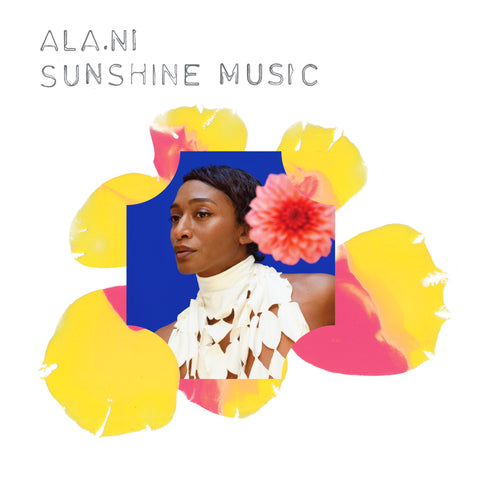All songs are written by ALA.NI, composed by Marvin Dolly and ALA.NI, arranged by Clément Petit and ALA.NI
Songs published by Nø Førmat / ALA.NI except
Tracks produced by Clement Petit & ALA.NI
Recorded at Studio 12 Ter, Montreuil, Fr by Mathieu Nogues and Sebastien Tondo
Except backing vocals recorded at BLZ studio, Paris, Fr by Mateo …
Mixed and mastered by Bassy Bob Brockman at Everblu studios, NY, USA
Executive production and A&R - Laurent Bizot
Artwork - Jérôme Witz
Design - Element(s)
(P) & © 2025, Nø Førmat!
When ALA.NI began writing Sunshine Music, her third album, the Paris winter of 2023 was in full, freezing force. Composing beneath layers of duvets in her apartment in Opéra, she drew warmth not from her surroundings, but from memories of the Caribbean sun she had recently left behind.
What was supposed to be a two-week trip in December 2020 turned into two and a half years across Barbados, Grenada – where her parents had grown up – and then Jamaica — an extended sojourn that offered a new sense of self. "Living in Jamaica was the first time I had lived in a Black-majority country," she says. "Jamaicans are very unapologetically themselves. I’ve chosen to live in Paris, and I feel more myself and more expressive and more comfortable here than I did in London, and more appreciated and valued as an artist too. But there are microaggressions and microracisms that we have to live with every single day as People of Colour. When I moved out of that environment, I was like, 'Shit, that's what I've been dealing with all this time.' I was just getting on and accepting certain negative behaviours as an act of mental survival."
In Jamaica, music flowed naturally. She collaborated with Sly Dunbar, one of the island’s legendary drummers, coaxing him out of near-retirement for an impromptu session. Life there — its rawness, its unfiltered expression — seeped into her bones and eventually into the songs she would later write, huddled against the Parisian cold.
Sunshine Music hums with the memory of that heat: a tapestry of influences stitched from calypso, jazz, bossa nova, and the great postwar songbook, threaded together by ALA.NI’s singular voice and sensibility. Across the album, familiar styles are honored without pastiche: the languid pull of reggae, the whisper of a bossa nova rhythm, the clipped phrasing of musical theatre. On This Is Why, she channels the warmth of a December romance into bossa-inflected sensuality, while Something You Said captures the rush of an unexpected connection through close, shimmering harmonies. Elsewhere, Hey Moon offers a late-night
lullaby intimacy, built around dampened jazz chords and whispered vocals.But what truly binds the record is its emotional core — a quiet resilience and a lingering warmth born of both memory and defiance. "I would never, ever call myself a jazz singer," she states. "I’ve been categorised that way but my writing is more likely to reference showtunes from The Sound of Music to Stephen Sondheim. And I grew up in a household where we listened to calypso and reggae and soca and zouk, so it’s important to make that distinction."
Some songs reach outward into broader political territory: Tief calls for reparations and confronts the legacy of colonial theft with quiet urgency, while Ton Amour weaves personal experience into a cautionary tale about narcissism and survival, set against a breezy reggaeton-tinged backdrop. Meanwhile, Blue Mountain remembers the simple, profound freedom of hiking Jamaica’s misty peaks — a snapshot of nature, transcendence, and bittersweet return.
Elsewhere, Seaweed captures the dreamlike memory of swimming through thick Caribbean waters, co-written in Miami with Liset Alea, while Rain on My Heart offers a tender promise to someone weighed down by sorrow — a hand extended toward the light.
Since emerging with her debut You & I in 2016 — a self-produced set of exquisitely restrained torch songs that earned her a performance on Later… with Jools Holland — ALA.NI has built a reputation as a distinctive voice beyond easy classification. Her 2020 follow-up, ACCA, layered beatbox and vocal textures into dense, intricate arrangements, drawing contributions from figures like LaKeith Stanfield and Iggy Pop. Along the way, she has collaborated and performed with artists as diverse as Mary J. Blige, Blur, Nitin Sawhney, Andrea Bocelli, Chassol, and Jon Batiste.
